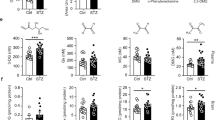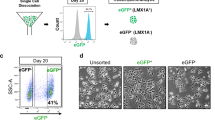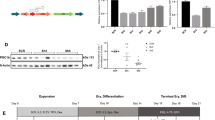Abstract
Most cells are thought to contain trace amounts of 2,3-diphosphoglycerate (DPG), as it acts as a cofactor in the interconversion of 2-phosphoglycerate and 3-phosphoglycerate by the glycolytic enzyme phosphoglyceromutase. DPG is synthesized from 1,3-diphosphoglycerate by the action of diphosphoglycerate mutase. Lowry et al.1 reported levels of 29 µmol DPG per kg wet weight brain tissue which is approximately 3 pmol per 108 cells, assuming that 1 g of brain tissue contains 109 cells. In contrast, erythroid cells contain 50–100 nmol DPG per 108 cells, depending on the species and the stage of development2. This is of the order of a 1,000-fold more DPG compared with non-erythroid cells. In red cells DPG concentration modulates the binding of oxygen to haemoglobin3,4. I show here that erythroid precurser cells also contain markedly raised levels of DPG.
This is a preview of subscription content, access via your institution
Access options
Subscribe to this journal
Receive 51 print issues and online access
$199.00 per year
only $3.90 per issue
Buy this article
- Purchase on SpringerLink
- Instant access to full article PDF
Prices may be subject to local taxes which are calculated during checkout
Similar content being viewed by others
References
Lowry, O. H., Passonneau, J. V., Hasselburger, F. X. & Schulz, D. W. J. biol. Chem. 239, 18 (1964).
Bartlett, G. R. Comp. Biochem. Physiol. 61 A, 191 (1978).
Oski, F. A. & Gottleib, A.J. Prog. Hemat. 7, 33 (1971).
Finch, C. A. & Lenfant, C. New Engl. J. Med. 286, 407 (1972).
Campbell, G. M., Weintraub, H., Mayall, H. & Holtzer, H. J. Cell Biol. 50, 669 (1971).
Friend, C., Scher, W., Holland, J. G. & Sato, T. Proc. natn. Acad. Sci. U.S.A. 68, 378 (1971).
Harrison, P. R. Nature 262, 353 (1976).
Tanaka, M. et al. Proc. natn. Acad. Sci. U.S.A. 72, 1003 (1975).
Yeoh, G. C. T. & Morgan, E. H. Cell Differentiation 8, 331 (1979).
Hu, H. Y., Gardner, J., Aisen, P. & Skoultchi, A. I. Science 197, 559 (1977).
Glass, J., Nunez, M. T., Fisher, S. & Robinson, H. Biochim. biopkys. Acta 542, 154 (1978).
Morgan, E. H. in Proteins of Iron Metabolism (ed. Brown, E. B.) 227 (Grune & Stratton, New York, 1977).
Yeoh, G. C. T., Bennett, F. A. & Oliver, I. T. Biochem. J. 180, 153 (1979).
Fahey, J. L., Buell, D. N. & Sox, H. C. Ann. N.Y. Acad. Sci. 190, 221 (1971).
Reddy, W. J. & Burns, A. H. Biochim. biophys. Acta 428, 476 (1976).
Kabat, D., Sherton, C. C., Evans, L. H., Bigley, R. & Koler, R. D. Cell 5, 331 (1975).
Scher, W., Parkes, J. & Friend, C. Cell Differentiation 6, 285 (1977).
Maeda, N., Chang, H., Benesch, R. & Benesch, R. E. New Engl. J. Med. 284, 1239 (1971).
Cooper, M. C., Levy, J., Cantor, L. N., Marks, P. A. & Rifkind, R. A. Proc. natn. Acad. Sci. U.S.A. 71, 1672 (1974).
Author information
Authors and Affiliations
Rights and permissions
About this article
Cite this article
Yeoh, G. Levels of 2,3-diphosphoglycerate in Friend leukaemic cells. Nature 285, 108–109 (1980). https://doi.org/10.1038/285108a0
Received:
Accepted:
Issue date:
DOI: https://doi.org/10.1038/285108a0



